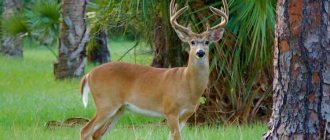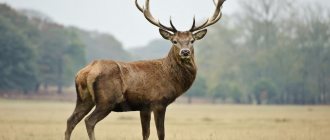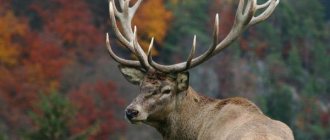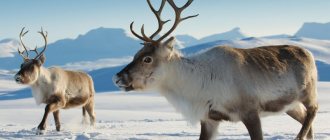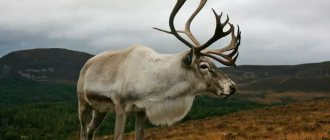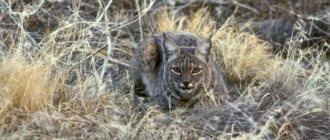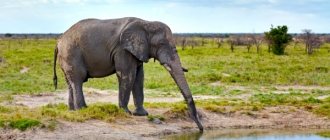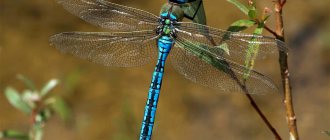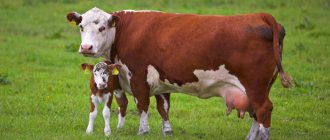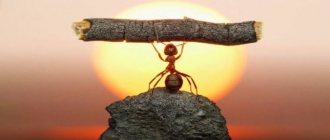Deer are the oldest mammals that lived in forests and steppes long before the appearance of humans. Slender, graceful animals with graceful legs and beautiful horns are rightfully considered the largest and most diverse family among ruminant artiodactyls.
Among the deer there are both dwarf species, whose weight does not exceed 10 kg, and real giants, with a body weight of 700 kg. Despite their common roots, deer can vary greatly in lifestyle and external characteristics. In this article you can get to know each subspecies better and appreciate the beauty and become noble animals
Deer and man
These animals are rightfully considered noble animals, since they have always been able to contact humans. Since ancient times, these animals were harnessed for the winter in order to carry sleighs, thus they served and still serve people. In Russia, some peoples devote their lives to one occupation - reindeer herding. Deer are raised not only for meat production, but also to maintain the population. Raising this animal by humans helps nature maintain its numbers in various parts of the world.
Deer are one of the favorite animal species of the ancient Slavs. That is why these animals are often found in fairy tales, stories and myths. They are also associated with kindness, comfort and, of course, celebration. Especially Happy New Year. These animals, and no one else, are in Santa Claus's sleigh harness, but why?
The thing is that deer are precisely the animals that our ancestors managed to tame back in ancient times. They served both as a means of transportation and as food. Special teams were built especially for them, where they transported various household items, crops, catch, animals from hunting, etc. There were cases when they were eaten; this was often done by hunters, and not by those who kept the animal on their farm. The love for these animals also prevailed. The owners warmed, fed and even raised the fawns in their houses, which was considered a sign of the nobility and prosperity of the family.
Status and population
Despite the fact that deer can easily adapt to any conditions, and today they live on almost the entire planet, certain species are on the verge of extinction. Among them it is necessary to highlight:
At the same time, sika and red deer cause the least concern. Their population is increasing, and their habitat covers almost the entire globe. It is very difficult to calculate their approximate number. But we can safely say that they are not in danger of extinction.
An interesting fact regarding rare, and especially endangered species, is that the decline in their population is, to begin with, due to the fact that almost all of them are endemics that inhabit a very limited area, for example, some islands lost in the ocean.
In this case, any deterioration in living conditions, some negative anthropogenic or natural factor can threaten both the population size and the direct existence of a certain species.
Deer description
This animal belongs to the deer family (from the Latin Cervidae). The animal belongs to the class of mammals and the phylum of chordates. The deer got its name from our ancestors – the Ancient Slavs. As they say in ancient manuscripts, people found a certain slender and horned animal, which was given the name “elen”. Having reached modern times, “fir tree” turned into “deer”. Due to some changes in the manner of speaking, the introduction of new words and time, many words that people use today have been changed. Animal names are a good example of this fact.
Are deer artiodactyls?
These animals belong to the artiodactyls, to the deer family. It is important that any animal belonging to the deer family is an artiodactyl mammal.
Appearance, food and restrictive body functions depend specifically on the variety of deer. Since many of them have distinctive features that are not similar to other species.
Appearance of deer, its varieties and structure
There are 51 species of these noble animals in the world. Classification of deer occurs taking into account the type of individual animal. Their sizes can differ radically, since some are too small, while others predominate in size. Thus, in terms of height and weight, the leader of the deer family is the elk. Its height can reach 2.3 meters at the withers, body length - up to 3 meters and weight up to 600 kilograms. Among the small species of this animal, the smallest was the mouse deer. Its height does not exceed 30 cm at the withers, and its weight is on average from 1.5 to 2.5 kilograms.
Body structure
The structural structure of deer is the same for all species. These animals are characterized by thin limbs. Their muscles are quite developed, so they have the ability to run faster and faster. Interestingly, these animals are among the five fastest animals on the planet. Also, their body structure is characterized by the presence of membranes on the fingers, which serve as connective tissues, as a result of which the animal can spread its fingers.
Teeth
As for the teeth, they are evidence of the age category in which an individual animal is located. Determining the age of a deer can be done by examining the oral cavity. This mainly concerns appearance. Age is determined by the following signs: the presence of curvatures, especially the animal’s fangs, thinning of the enamel. This is often used in nature reserves when capturing animals from independent habitats. The teeth are very strong and it will be very difficult for even the deer to break them.
Horns
The deer's antlers are its decoration. They are generally present in all species except Antlerless Deer. This accessory is unique to males. However, there is an exception - the female reindeer. The female of this species has small horns. The structure can be bony and branched in shape. Branched horns also have a name - antlers.
Antler shedding occurs annually in males living in temperate latitudes. It is worth noting that new horns grow quite quickly. First, cartilage is actively formed, which is gradually overgrown with bone tissue. Their growth is related to the quality of the animal’s nutrition. The better and more densely the animal eats, the more active and faster new ones grow. Deer antlers are shed taking into account their location and the actual climatic conditions. Thus, males living in the tropical zone may not shed their antlers for years. But in the equatorial belt, animals never do this at all. Deer antlers serve as protection in the process of fighting for a female or in a battle with another animal for its own life. Also, a deer with antlers has the ability to clear a path for itself in difficult conditions.
Mental capacity
They are intelligent and resourceful animals that teach their young to be safe and independent from birth. Often they become targets for predators. That is why almost all varieties of this animal have a well-developed intuition, as well as a sense of the proximity of a predator. Nature has endowed deer with thin and strong limbs. Thanks to them, they can run fast and jump over all obstacles that come their way. It is worth noting that this animal is recognized as one of the fastest animals on earth.
Interesting Facts
Deer are a diverse and amazing family. Each species is beautiful in its own way and has its own unique features.
Interesting Facts:
- The smallest horns weigh no more than 200 g, the largest about 30 kg.
- Reindeer are the only mammals on the planet that can see in the ultraviolet spectrum.
- Until the age of 12, deer antlers grow and develop every year. After this age, the horny processes begin to shrink and look less luxurious every year.
- Young horns are called “ponts”; they are very sensitive and tender. If wounded, deer experience pain, and blood bleeds from the antlers, as there are blood vessels and nerve endings there.
- Water deer are hornless, but have well-developed fangs.
- According to scientists, the first representatives of the family lived on the planet more than 33 million years ago.
- Reindeer normally form separate herds of adult males and females. During the rutting season, the herds split up. Juveniles, regardless of gender, prefer to be near adult females.
- The female reindeer (caribou), unlike other subspecies, has antlers.
- Deer have many enemies, but the greatest damage to the population comes from humans.
- Antlers have amazing healing properties, and “bone” horns are used to produce powerful immunostimulants.
- During the rutting period, deer lose all caution and become extremely aggressive.
- Little fawns can stand on their legs within a few hours after birth. And after three to four days, the babies can follow their mother over long distances.
- At the command of their mother, deer cubs lie down in the grass and freeze. They will lie like this until their mother calls them. Sometimes people found cubs that did not move even after they were discovered.
Where do deer live?
The deer family is distributed across almost all continents. They adapt very quickly to new living conditions and therefore can live in different climates, on different continents, where people bring them. The most active animal populations are in the following countries:
- Russia;
- North America;
- African continent;
- Australia;
- South America;
- Asian countries;
- Countries of Europe.
Of course, each region is home to certain species adapted to climatic conditions. Many of them, especially in Australia and America, live in nature reserves or zoos. Such living conditions are the most favorable for the animal and increase their lifespan. Since in captivity the animal lives 25-30 years, and in the wild no more than 15 years.
Deer are animals that can live both in mountain plains and forests. Deer feel quite comfortable in the forest, especially during mating periods or extreme heat. Most deer settle near bodies of water, because wet places are a high comfort zone for them. Animals lead a nomadic lifestyle, which is another reason for their habitat in the forest in the summer. In the winter season, deer prefer to stay in impenetrable thickets. This choice is due to the fact that due to the abundance of trees, less snow falls. Under these conditions, it is easier for deer to find food.
Roe deer
They are also called roe deer or wild goats. They live mainly in Eurasia. They are divided into European (living throughout Europe and partly in Western Asia) and Siberian varieties (larger than the first, living beyond the Volga, in the Urals, Siberia, the Far East and Yakutia).
Both species are animals with a slender build and a long neck. The legs are graceful and straight. The head is small, neat, with long and wide ears, as well as far apart eyes.
Horns with three branches at the top. The entire surface of the horns is covered with tubercles and protrusions. Body color is dark red, gray-brown in winter. There is a large white spot in the tail area.
What do deer eat?
Deer are not carnivorous animals. They mainly eat vegetation, depending on their needs at certain times of the year. So, in the spring and early summer, these animals prefer: cereals and legumes.
Their preferred food during the summer season is:
- Mushrooms;
- Berries;
- Chestnuts;
- Nuts;
- Seeds of various plants.
During the warm season, they also eat:
- Flower buds;
- Leaves and shoots of plants;
- Leaves of maple, rowan, aspen and viburnum;
- Fruits or seeds of pears and apples.
During the winter months, animals are forced to eat:
- Tree bark;
- Tree branches;
- Lichens;
- Needles;
- Acorns.
In many cases, animals are observed gnawing on their own shed antlers. This process is caused by a lack of protein in the animal’s body. Due to their structure, horns retain a lot of protein in their composition. Therefore, deer gnaw their own antlers in order to compensate for the lack of protein in the body. Also during this period, animals feel the need for minerals. To replenish supplies, animals:
- drink water from mineral springs;
- eat raw earth. Eating soil allows the body to replenish the substances it needs;
Nutrition
Since the deer is a herbivore, its diet depends on the places in which the deer lives, or more precisely on the vegetation of those places. Many deer eat
leaves, young shoots of trees, grass, branches of bushes, and also tree bark, which serves as a significant part of their diet. Deer will not refuse to eat ripe fruits of apples, pears, and various berries. Reindeer living in the tundra love to eat moss, which they dig out right from under the snow with their branched antlers.
Types of deer
They include 51 varieties, as well as 3 subfamilies and 19 genera. It is worth noting that representatives of the deer family also include:
- Doe;
- Puda;
- Roe;
- Elk;
- Mazam;
- Muntazhka;
- Axis;
- Barasingha;
- Zambra.
Noble deer
Red deer (from Latin Cervus elaphus). This species is one of the most common in the world. It includes 15 subspecies, which differ in color and horn structure. It is worth noting that this animal is also called a red deer. This name is due to its color at certain times of the year. The habitat of this species belongs to Western European territory and Scandinavian countries.
In particular, the population of red deer is observed in the following countries:
- People's Republic of China;
- Algeria;
- Australia;
- USA;
- Moroccan Republic;
- New Zealand.
A characteristic feature of the red deer, which unites all subspecies, is the white spot located exclusively under the tail. It is noted that in the summer season, this species does not have spotting in color. The distinctive features of animals of this species lie in its structure. The most slender among all species is the noble one. He has a proportional build and an elongated neck. Its head has a slightly elongated shape. The beast has a wide and slightly arched forehead. The color of his eyes is usually yellow-brown with blue tear grooves, which are located near the eye sockets themselves. This structure of the eyes allows you not to damage the eyes during changes in climatic conditions, as well as in the event of any kind of disease, including an allergic reaction. Deer antlers differ depending on the subspecies of the animal. The European species has a distinctive feature - a significant number of branches on the horns, which form a kind of crown at the end of each horn. The size of a red deer also depends on its subspecies. Such animals can reach 2.5 meters in length and 1.6 meters at the withers. The weight category of the subspecies exceeds 300 kilograms.
In winter, deer of this species feed on vegetation in the form of foliage, chestnuts and tree bark. In spring and summer, animals prefer fruits, seeds, grains and grass. Animals of this species will not refuse legumes either. The most important habitat factor is the presence of a body of water near their location. Grace deer exist and move exclusively in herds, where they can number from 10 to 30 individuals.
Wild Reindeer
Wild Reindeer (from Latin Rangifer tarandus). This type differs only in appearance. Unlike other individuals from the deer family, Wild Reindeer has an elongated head shape. The physique is also not similar to other individuals. He has a stocky build. The main distinguishing feature is the upper lip, which is covered with hair. The peculiarity of this species is that the reindeer has antlers, both male and female. However, it is noted that the female antlers are much smaller in size. The size of an adult animal is up to 2.1 meters in length. Weight category: up to 190 kilograms. The female Reindeer has a size of up to 1.9 meters in length, and the weight category of the female reindeer is up to 130 kilograms.
Reindeer feed mainly on leaves, grass, and berries. If deer feel a lack of protein, they look for birds' nests. Where they eat the eggs, and sometimes the chicks themselves. There have been cases where animals of this species ate rodents such as lemmings, which was also based on a lack of protein in the body. During the winter season, deer in the tundra find and eat reindeer moss.
Reindeer live in the tundra and taiga. The location of these animals refers to the following countries:
- Islands of the Arctic Ocean;
- Eurasia;
- North America.
This type of animal lives in a herd. They wander only when the season changes and in search of food.
Water deer
Water deer (from Latin Hydropotes inermis). This species differs from its relatives in the complete absence of horns. The size of this species reaches 100 cm in length, height is 55 cm. The weight category of this species can reach from 9 to 15 kg. A distinctive feature of the water deer is its fangs of an unusual shape, which is not characteristic of any other subspecies of deer. They are saber-shaped and curved, protruding from under the upper lip. The characteristic color of this animal is brownish-brown. Water deer feed mainly on leaves, shrubs and grass. This species lives in central China, as well as on the Korean Peninsula.
In the regions of Australia and France, water deer were introduced relatively recently. However, the animals quickly adapted to the climate that was unusual for their bodies. This species is also different in that an individual animal does not live with the herd, but exists independently. Water deer are exclusively solitary. They find a mate only once, during the rutting period. In search of food, animals can swim long distances. This ability is another distinguishing feature from its relatives.
Dappled deer
Sika deer (from Latin Cervus nippon). Individuals of this species grow up to 1.8 meters in length, with the smallest deer reaching just under 1.6 meters in length. Size at the withers: from 95 cm to 112 cm. The color of the deer depends on the time of year. So, in the summer season the animal has a bright red-red color, and in winter the color of the skin fades and becomes faded red. The diet of sika deer is limited to a temporary period. In summer they eat:
- Berries;
- Fruits;
- Grass;
- Foliage;
- Young alder shoots;
- Young shoots of oak;
- Mushrooms;
- Nuts.
Winter is the harshest period of life for these animals. To get food for food, deer spend a long time searching under the snow for foliage and any vegetation that can serve as food. Typically, during a hungry winter, red deer consume:
- Dried leaves;
- Tree bark;
- Acorns;
- Seaweed.
Animals consume algae if they are near water bodies. Sea plants help the deer body balance the mineral balance, which is in short supply during the harsh winter period.
The small deer lives exclusively in herds. One herd, as a rule, numbers from 10 to 20 individuals. Spotted deer live on the territory of Russia, mainly in the regions:
- Caucasus;
- Far East.
Sika deer prefer mountainous, flat and foothill areas for habitat.
Siberian deer
Most of the population of this species lives in the forests of Siberia. They can also be found in Korea and Northern China. This animal is one of the largest species of deer that has been identified on the planet. The size of such a deer can reach from 200 centimeters to 225 centimeters in length. The height of the animal ranges from 140 centimeters to 160 centimeters. Weight category: from 170 kilograms to 250 kilograms. Female Siberian deer are slightly smaller in size than males. The body length ranges from 180 centimeters to 216 centimeters. The height ranges from 115 centimeters to 120 centimeters. Weight category: from 140 kilograms to 180 kilograms. The male's horns reach 87 centimeters in length and span up to 85 centimeters in diameter.
The color of the skin, like other species, depends on the time of year. In the summer season, the skin has a bright red color. A distinctive feature of this species is the black stripe located along the back of the animal. In winter, the color fades a little. Red deer can turn a light gray color. Hair grows on the neck, forming a mane with a brownish-gray tint.
The diet of Siberian deer is no different from other species. They also eat vegetation in the form of foliage, shrubs, grass, acorns, mushrooms and fruits. He is a nomad. Its habitat directly depends on the time of year. So, in the summer, the animal strives to move to the mountains, where it roams until winter, when the animal again descends to the ground and looks for taiga territory with dark coniferous forest in order to successfully wait out the cold months.
Indian deer
This species is considered the largest in the deer family. Its habitat is considered to be Hindustan. The average height of the animal reaches 140 cm, and its weight can reach 320 kg. Also, this species differs in the size of its horns. Sometimes they reach 129 cm in length.
The characteristic color of the Indian deer is light gray-brown. As a rule, the animal lives near bodies of water. Like other species of the family, it feeds on vegetation, which it searches for on its own.
This species is predominantly nocturnal. During the daytime, Indian deer hide in impenetrable thickets and forests, where they move completely silently, despite their overall size.
The animal lives not only in Hindustan, but also in such countries as:
- Southern part of China;
- Iran;
- Southeast Asia;
- New Zealand;
- Chile;
- Australia;
- Türkiye;
- USA;
- Azerbaijan.
elk deer
The species is a tall deer with a short and thick neck and extended limbs. Sokhaty has large nostrils, a swollen upper lip and a short tail. It is noted that they have wide hooves. The habitat of these animals is in the forests of the entire north. The elk species is common in some countries:
- In Russia (especially in Siberia);
- In Scandinavian countries;
- In North America;
The size of the animal, as a rule, reaches 2.1 meters in length. Weight category: from 300 to 400 kilograms.
The animal feeds like other species: leaves, branches, acorns, and so on. It settles mainly in the tundra or forest.
musk deer
This species is a small-sized animal that lives in Russia in the Far East and Southern Siberia, as well as on the territory of Sakhalin Island. The distribution of the species is prone to mountain taiga. The musk deer is quite cautious due to its keen sense of self-preservation; it senses the approach of a potentially dangerous creature and quickly hides in the taiga.
This species has a brown or dark brown coat with white spots. This coloring serves as an excellent camouflage cover from predators. A distinctive feature of this species is its fur; it is long and thick, which cannot be said about its relatives.
The size of the musk deer is no more than 105 cm in length, height 65-70 cm. It is noted that, due to its structure, the animal makes fairly long jumps. This skill often saves his life.
Another difference from the family is the presence of fangs. The musk deer's teeth are quite long and resemble the tusks of a boar. The use of these teeth occurs during the rutting season. During this period, deer become the most aggressive and often fight among themselves for the female. In most cases, such a fight leads to the death of one of the opponents.
- European reindeer. This type of deer lives mainly in Russia in the Murmansk region. An animal that has reached childbearing age weighs from 150 kg. European reindeer often live in the forest. The diet of European reindeer is no different from its relatives. It is important to note that today this species is widespread in:
- Northern Europe;
- United States of America;
- Territories of Asia.
This animal leads a nomadic lifestyle. It roams exclusively in a herd, which can number up to 30 individuals. It is noted that during the rutting period, several females gather around the male, who will subsequently give offspring to their chosen one. In winter, as a rule, females and males separate. Some go to the mountainous areas, while others go to the calving area.
White-tailed deer
White-tailed deer. This species is the most widespread in the United States and is distinguished by its amazingly colored tail coat. The top of the tail is brown and the bottom is white. This is where the accompanying name of the species came from. The minimum weight reached by the beast is 150 kg.
Typically, this type of deer eats green and young bushes, branches, young shoots and succulent flowers. Often, white-tailed deer find and feed on cereal grains and all kinds of seeds. In the autumn, they eat exclusively fruits and berries; they also do not refuse nuts. During the harsh and snowy winter, they have to feed on tree bark and dried leaves.
They live mainly in forests or on mountain slopes. This species does not lead a gregarious or nomadic lifestyle. White-tailed deer are solitary animals. A herd can only be formed during the rutting season, when they need to mate to procreate.
Tufted deer
A distinctive feature of this species is the presence of a black crest on the animal’s head. The length of this crest is 17 cm in length. Adult deer can reach from 110 to 116 cm. The weight of a tufted deer ranges from 40 to 50 kg. The horns of this species are not large and do not differ in branching. You may not notice them under the crest. These animals feed not only on bushes, branches, berries and fruits with cereals. They are characterized by eating carrion, which serves as the main source of essential protein. Crested deer are quite cautious and love privacy. The animal senses the appearance of a predator, and the deer immediately disappears into the forest. The animals live in forests in the Asian region. By nature, this species of deer is solitary. They gather in a small herd only during the rutting season.
Subfamily Water deer (Hydropotes)
This subfamily contains only one species with two subspecies. Water deer (Hydropotes inermis) is common in China and Korea. Its habitats are swamps, river floodplains and wet savannas. These animals are excellent swimmers and can easily swim several kilometers in search of new territory. Water also serves as a refuge for these deer - here they are relatively safe.
Body length is about 100 cm, height – 48-52 cm, weight – 11-14 kg. Water deer do not have antlers, but the males are armed with long upper fangs in the form of tusks about 7 cm long (ancient deer that lived about 30 million years ago had the same fangs).
Water deer (Hydropotes inermis)
The color is reddish-brown in summer, dull brown in winter. Juveniles are dull brown with faint spots along the spine.
- Tupaya
- Squad Squamate
- Beaked whales - what...
- Lynx: species,…
- Family…
- Prodolphins
Reproduction and mating of deer
The mating period for deer occurs in early autumn and ends with the first frost. It is during this period of time that females are ready to reproduce.
Before conception, the process of “getting to know” females begins. Males display themselves by beating trees with their antlers and loudly howling. Interestingly, horns play a significant role in conception. The fact is that it is in them that this animal contains the hormones responsible for sexual life. This explains their behavior during the mating period. Its main advantage is its antlers; it sheds only after the end of this period, after which new ones grow quite actively. By the horns, you can also determine the health, as well as the physical and sexual condition of the animal. The process of knocking antlers on trees is due to the fact that the antlers stop receiving the necessary blood flow. The skin lying on top of the horns is already dead. Therefore, during this process, dead skin flies off. If, after getting rid of dead skin, wounds remain on the head, then this state of the deer indicates its dysfunction in the sexual sphere.
Females during the rutting period are completely ready for mating, both physically and psychologically. Certain traits that appear in females attract males exclusively for the mating process. These signs include:
- Heat;
- The appearance of a strong odor in the hooves and anus.
The age category of females and males ready for offspring is determined at 2.5 years for both sexes. It is noted that older females can rarely conceive and give birth to cubs. If they do manage to acquire it, then the baby deer will be much weaker than those of young animals.
As a rule, a deer has many females that it can impregnate during the rut. Usually one male has at least 10 partners during one fertilization period.
Mating season
Deer gather in small herds, which consist of several adult females, cubs and a strong male during the mating period. In the fall, many deer begin their rut, which ends at the beginning of winter. Throughout the mating season, the roar of a deer can be heard at an impressive distance.
At this time, males often sort things out among themselves. The main weapon of struggle is the horns. With them the deer tries to knock the opponent to the ground. Sexual maturity in males occurs at 2-3 years. In females even earlier - by 1.5 years.
Baby deer
Fawns are small brown animals, sometimes with small white or brown spots. These little cubs are somewhat reminiscent of human children. They are just as cute and clumsy. They require a lot of attention and care from the mother. It is worth noting that these animals have a maternal instinct. The male has only the instinct of reproduction. Therefore, the “raising” of the fawns falls entirely on the shoulders of the female.
Once born, a deer calf can only stand on its feet. And this process is quite difficult for him, since after birth the baby is quite weak and his limbs are subject to shaking.
Up to a certain point, when the fawns learn to eat grass, they suck the female's milk. It is reindeer milk that is saturated with mineral fats, which are very useful not only for immunity, but also for weight gain. Therefore, the cubs quickly get to their feet and begin to run.
As a rule, the female does not leave her offspring alone, but keeps them near her. This behavior of the mother is explained by her concern for the safety of her cubs. In the event of a predator attack, the female always tries to take the fawn and run away. She will always protect her cubs, since the maternal instinct will prevail over the instinct of self-preservation. The main task of the female will be only to save her offspring.
She teaches her children where to look for food and how to hide from predatory animals. The grown-up baby deer leaves the female on its own. This usually happens when he begins the process of growing horns. These look like small swollen bumps on the deer's head that are growing rapidly. A deer with antlers is an absolutely independent animal. Since when they appear, he will be able to independently obtain fruits from trees and dig out food from under snowdrifts.
What is the difference between deer and elk?
People often confuse completely different animals. These two animals belong to the same family, but still have a number of differences.
- Horns. They differ significantly in these animals. In moose, they tend to develop horizontally and have branches that are much wider than deer antlers.
- Legs. Moose have higher limbs and are slimmer in shape.
- Moose do not form herds. They exist either completely alone or in the company of a constant companion.
Enemies of deer in nature
In nature, these animals have a huge number of enemies, since on each continent they can be hunted by several predators at once. Wolves, leopards, hyenas, bears, tigers, pumas - all these animals are different, live in different conditions, but deer are hunted constantly.
Winter is also a villain for many species, as a thick layer of snow pulls the animal away from the food it is accustomed to.
If the deer cannot dig out food from under the snowdrift, then they automatically become lunch for the animal, which is in search of fresh meat.
Humans cause colossal damage to the population of this animal, since deer hunting is a favorite method of pampering oneself. But the extermination of these animals did not alienate them from people. Many species independently approach humans, visiting villages and highways.
Deer in nature reserves
This animal is not whimsical and does not require careful care. Depending on its species, it can exist in certain climatic conditions. However, today most animals adapt to any climatic zone. It is noted that the life of deer is on average 10-15 years in the wild. In conditions without freedom, such as protected areas and zoos, the animal can live longer, up to 20 years. Such indicators are due solely to nutrition. During severe winters, deer in the wild practically starve. This can easily be explained by the fact that not every animal will be able to choose a suitable place for wintering. In some forests, the layer of snow may be so hard and thick that he cannot dig through it with his horns. Without receiving the necessary microelements for life, animals age faster physiologically. As for the protected area, here the deer eat what they need at any time of the year, which is why their vital indicators are many times higher.
Adaptation to new climatic conditions
Deer species provide a much broader view of the deer population as a whole. The distribution of a particular species in a certain area suggests that another species from the deer family can also adapt to these climatic conditions. This animal can move from one environment to another without much harm to the body, for example, a deer in the forest at a certain period of time may feel as comfortable as possible, but after some time it may need to change its place of residence. Depending on the species, the animal can be small or large in size. The key to survival is to be able to use your horns to find food in harsh climates.
Lifestyle and character traits
The life and habits of deer differ according to species and territorial characteristics. Most species are diurnal, which can vary depending on conditions. In the summer heat, almost all species prefer to escape in the forest shade and cool reservoirs. At such times, deer go out to pasture only at dusk. In winter, autumn and spring, deer graze during the day and roost in the forest and tall bushes at night.
Lifestyle of deer
Depending on the species, deer prefer to remain alone or gather in small groups. Some species look for a mate only during the rutting season, while others form permanent families. This behavior depends not only on the species, but also on the time of year, as well as the availability of food.
For example, reindeer in normal times prefer to graze in same-sex groups of 20–30 individuals. Herds break up and reform during the rut.
Sika deer form families with one mature male, 3–5 females and cubs.
David's deer, Noble and White-faced deer do the same. Water deer, tufted deer and elk form pairs only during the breeding season.
But the migration of deer in search of food forces the animals to form herds of 10 to 40 individuals, without distinction by gender and age.
In the summer, deer prefer to stay closer to open areas where there is a lot of lush grass and bushes. In winter, the herds begin to migrate in search of food and often go deep into the forest, where there is no thick layer of snow.
Representatives of the family live in one familiar territory, which can extend over several hundred hectares. But if some threat arises or food runs out, they leave their usual areas and leave.
Character and habits
By nature, deer are peaceful and timid animals. But their mood changes during the rutting period. During mating games, males become aggressive and can attack an animal of another species or a person. This period lasts from 1 to 1.5 months.
Family groups are headed by a large and strong male, he protects females and cubs from predators and rivals.
